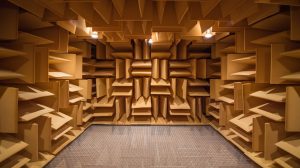
The anechoic chamber in the National Center for Physical Acoustics is one of the many demos open to the public during the facility’s 30th anniversary celebration Oct. 14.Photo by Kevin Bain/Ole Miss Communications
OXFORD, Miss. – As the Jamie L. Whitten National Center for Physical Acoustics enters its 30th year of operation at the University of Mississippi, the acclaimed research facility is celebrating with an open house, including demonstrations of interesting acoustical principles and phenomena.
The free event begins at 1 p.m. Oct. 14. Scheduled activities include demos of various projects, guided tours and screenings of a video detailing the facility’s progress.
“We’ve tried to create a nice balance of demos to be both scientific and entertaining,” said Craig Hickey, interim director, senior research scientist and associate research professor of geological engineering and physics. “Our objective is to have something that appeals to everyone, from the scientist interested in state-of-the-art technology to the middle school student curious about acoustics.”
“By allowing the public this expanded opportunity to see what’s being done here, we hope to close the margin in their understanding of our work,” said Nathan Murray, associate director, senior research scientist and assistant research professor of mechanical engineering.
Demos scheduled thus far include the center’s anechoic chamber, an acoustic water fountain, acoustic flashlight, jet flow visualization and sounds of sediment.
“Standing in the anechoic chamber, you will experience what a world without sound reflections sounds like,” Hickey said. “Without objects for sound to bounce back off, everything is much quieter.”
The sounds of sediment are “what keep fish awake at night,” Murray said.
“We can hear the sound that sand and pebbles make as they flow downstream,” he said. “It raises the question of why do fish have ears if all they can hear is the noise made by moving sediment.”
NCPA started in October 1986 as a scientific curiosity and a grand idea among acoustics researchers in the UM Department of Physics and Astronomy. Once they proved that acoustics could anchor valuable technology for numerous military and commercial applications, a congressional act mandated that significant funding be awarded for equipment and facilities to continue the group’s studies.d
Over the past three decades, NCPA has grown to an 85,000-square-foot facility housing an eclectic group of world-class acousticians working on projects at the forefront of science and technology.
“Acoustics are like sound fingerprints of systems,” Murray said. “Every material thing in the world has an acoustic fingerprint attached to it.”
During NCPA’s first decade, scientists discovered that fire ants “talk,” developed acoustical instruments to detect tornadoes and count catfish in commercial ponds. They also developed earphones that reduce the painful racket in deep-sea divers’ helmets, developed an improved stethoscope for physicians in noisy environments and made the first observation of stable, single-bubble sonoluminscence, which is brief bursts of light given off by bubbles in a liquid as they implode after being hit with sound waves.
The center’s research team also established an international reputation as experts in outdoor sound propagation.
“Our second decade saw the creation of an acoustics research group under the direction of John M. ‘Jack’ Seiner,” Hickey said. “We also formed a formal NCPA-Army partnership in the Acoustic Center of Excellence. NCPA director Henry ‘Hank’ Bass was awarded the Acoustical Society of America’s Silver Medal in 2006.”
The NCPA played a leading role in the establishment of infrasound stations around the world for monitoring large explosions for the Comprehensive Test Ban Treaty, which outlaws tests of nuclear weapons. The center’s scientists also examined ways data from these stations could be used to predict hurricane tracks and warn airline pilots of remote volcanoes.
The center’s third decade began with the opening of a one-of-a-kind tri-sonic wind tunnel facility. Unfortunately, NCPA also lost both Bass and Seiner in 2008 and 2010, respectively. Undaunted, the remaining scientists pulled together under the leadership of James P. Chambers, interim director, who transitioned two years later to become associate dean of engineering and associate professor of mechanical engineering.
Taking the center’s reins in 2013, Joseph Gladden III became director, bringing stability and national recognition to NCPA in his roles as chair of ASA’s physical acoustics technical committee and member at-large for the topical group on instrumentation and measurement science in the American Physical Society. Gladden became the university’s interim vice chancellor for research and sponsored programs earlier this year, and Hickey is serving as interim director.
Since its inception, NCPA and its scientists has:
- received $225 million in funding from government and private entities;
- published more than 660 referred journal articles;
- made over 850 presentations;
- had 10 fellows of the Acoustical Society of America;
- had six associate editors of ASA journals;
- had one ASA Journal editor-in-chief;
- filed more than 15 U.S. patent applications
- had more than 75 technology transfer agreements executed;
- had nine active U.S. patents issued and four license/option agreements;
- awarded Ph.D. degrees to 20 students working with the facility;
- had more than 400 students involved in undergraduate and postgraduate research projects.
NCPA’s research team looks forward to many more years of success, the center’s administrators said.
“So many things that were science fiction 30 years ago are now common realities,” Murray said.
“And while no one can foresee what the future holds, NCPA is definitely poised on the cutting edge of whatever is to come,” Hickey said.
For more about the Jamie L. Whitten National Center for Physical Acoustics, visit http://ncpa.olemiss.edu/.